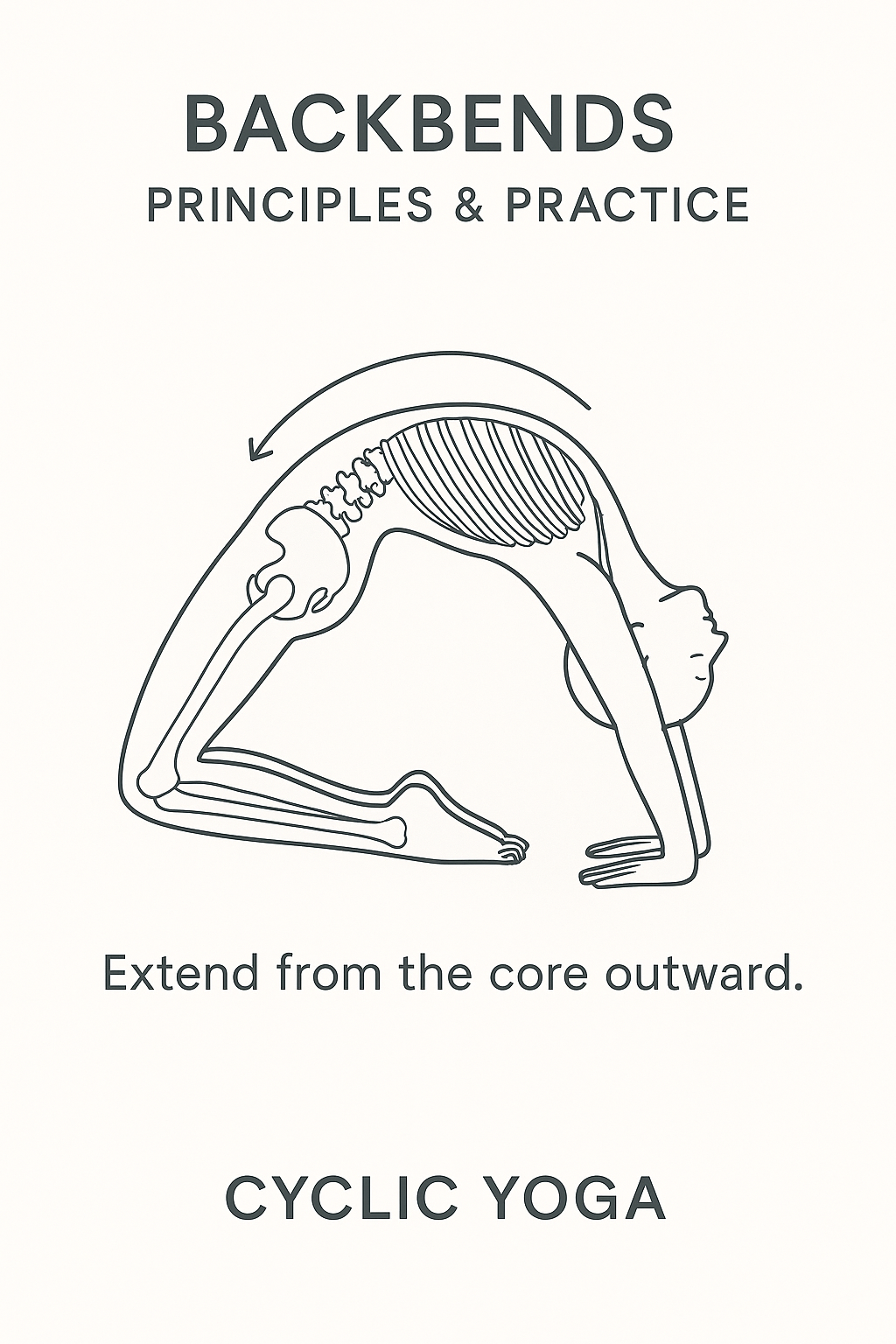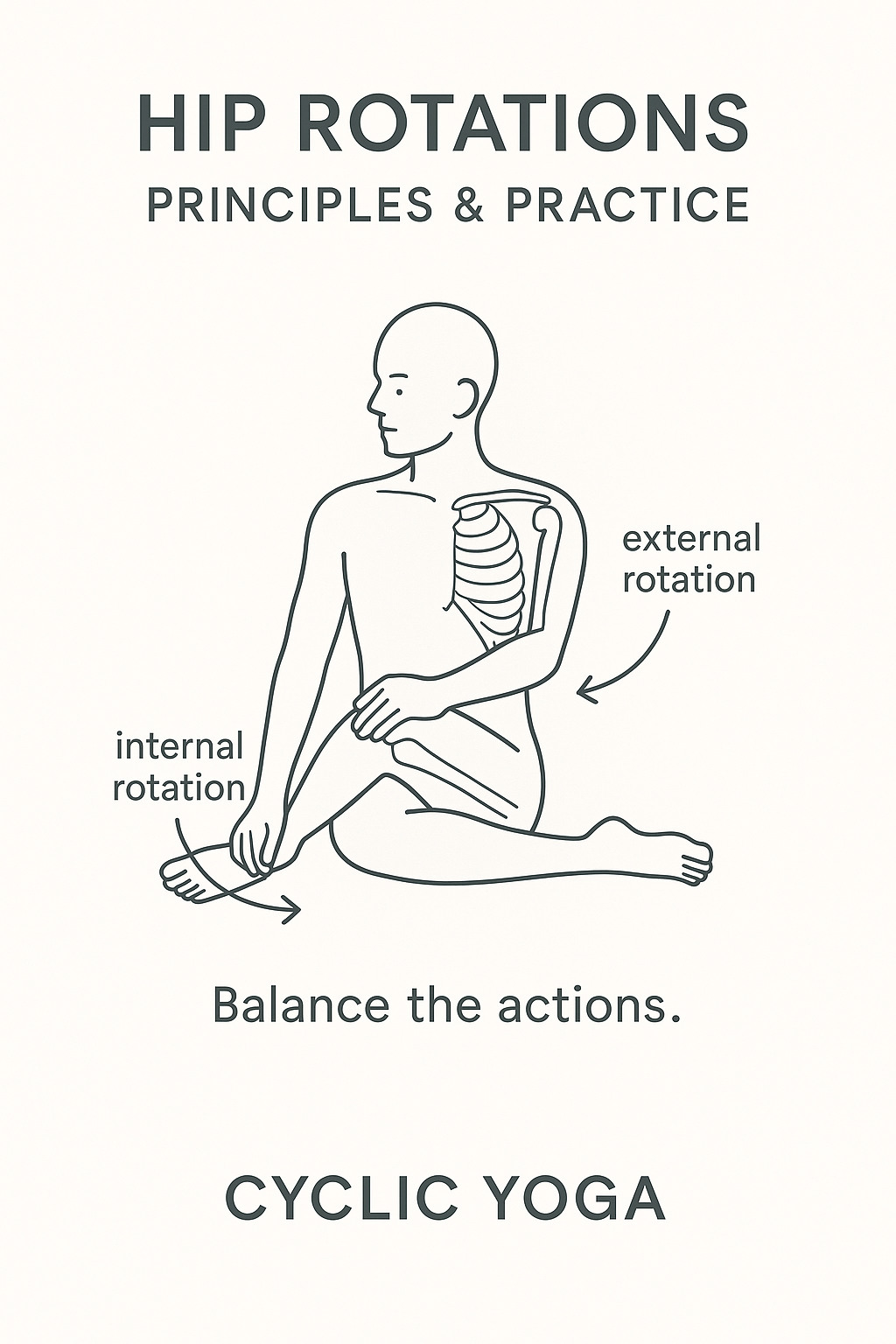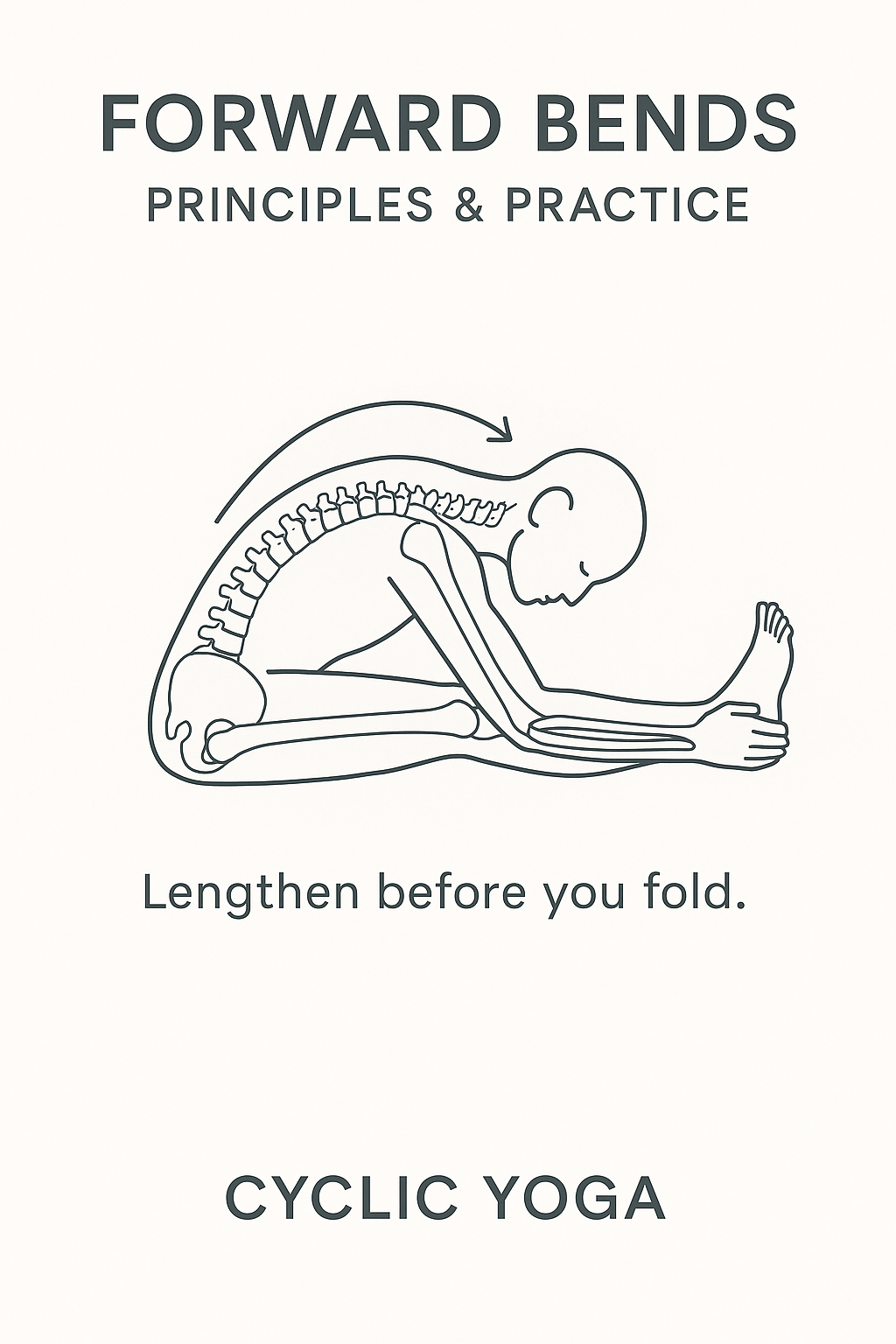Techniques for Practicing Cycles
Each cycle in Cyclic Yoga consists of a series of asanas and preparatory (facilitating) movements. Special attention is given to the sequence and structure of postures within each cycle. The arrangement of movements is carefully designed based on their level of difficulty and the body’s readiness to transition into the next pose—much like ascending a staircase, step by step.
The sequencing ensures that each asana supports and enhances the physical and therapeutic effects of the others within the same group. Each posture in the cycle prepares the body—through specific muscular engagement and stretching—for the next one, allowing students to flow smoothly and safely through a logical chain of movement.
Timing Matters in Cyclic Yoga
Time of practice plays a crucial role in Cyclic Yoga. Whether the goal is to increase physical energy or to calm the body and reduce stress, the time of day chosen for practice should align with the desired outcome:
Morning Practice: If practicing early in the morning, it’s best to begin with a few reclined movements to gently awaken the body, then progress to standing or energizing sequences (e.g., Energizing Cycle). This will boost vitality and prepare the body and mind for the day ahead.
Evening Practice: For evening sessions, it’s better to start with standing or seated movements to ease the body into a state of relaxation. This helps prepare for restful sleep and supports the body’s natural winding-down process (e.g., Anxiety Relief Cycle or Stress Reduction Cycle).
Seasonal Adaptation of Practice
Cyclic Yoga also takes into account the impact of seasonal changes on the body. Aligning your practice with natural rhythms helps harmonize the body with environmental energies:
In the cold and dark days of winter, cycles that include backbends, standing poses, or inversions (e.g., Bhujangasana Cycle) can invigorate the body and help ward off seasonal depression.
In hot summer months, cycles with forward folds (e.g., Relaxation Cycle) help regulate body temperature and promote a sense of inner cooling and calm.
Frequency and Safety in Practice
For optimal results, it is recommended to practice a cycle every other day. The Cyclic Yoga method incorporates safety protocols to prevent injuries and ensure progressive physical development.
The structured inclusion of facilitating movements between primary asanas gradually deepens the muscular engagement—from superficial layers to deeper tissues—without overloading the body. These supportive movements are essential; they make transitions smoother, enhance the effectiveness of the primary asanas, and serve as a safeguard against injury—much like a safety valve.
Neglecting the facilitating movements or performing postures without proper sequencing can lead to short-term discomfort or long-term harm, particularly in individuals with specific physical conditions. Cyclic Yoga has been deliberately designed to eliminate these risks through intelligent sequencing and anatomical awareness.
Reducing Confusion, Enhancing Retention
As students learn yoga, they are often introduced to a wide array of postures, which can lead to confusion about daily practice structure. Cyclic Yoga simplifies this process. Students quickly memorize the order of each cycle and never forget the preparatory steps essential for safe and effective practice.
Each cycle targets a specific area of the body, and when practiced collectively, all major body systems benefit. Regular practice of Cyclic Yoga improves flexibility, reduces physical and mental tension, and offers a host of additional benefits:
Relief from fatigue and muscular stiffness
Reduction in stomach acid levels
Strengthening of the immune system
In today’s fast-paced world, Cyclic Yoga offers a time-efficient method to gain maximum benefit from yoga with minimal investment of time—making it an ideal daily wellness practice.
How to Perform Cycles
Preparing the Body and Mind for Structured Asana Practice
Before engaging in a full cycle, it is essential to learn the correct technique for each individual asana included in that sequence. In the Cyclic Yoga method, postures are first taught across three progressive levels—beginner, intermediate, and advanced—each structured according to the physical demands and flexibility required for safe and effective execution.
Beginner Level
The first step is learning how to enter and exit each posture safely, along with understanding its benefits, limitations, and contraindications. This foundational phase emphasizes simple preparatory movements that gently increase joint mobility, release muscular tension, and condition the tendons and ligaments. These exercises are carefully designed to enhance softness and flexibility in the body and to gradually strengthen the abdominal, spinal, lower back, and leg muscles.
Intermediate Level
At this stage, students focus on mastering proper muscular contractions and stretches, gaining a deeper understanding of how the body functions in each movement. This includes learning key principles for safe and effective practice. Emphasis is placed on increasing the range of motion in key areas such as the hips and spinal column, while refining coordination between breath and movement.
Advanced Level
The final stage involves extending the duration of each posture, increasing both strength and flexibility. At this level, the practitioner develops a deeper anatomical and energetic awareness of yoga postures. Once a student is able to perform the correct shape of each asana—using optimal contraction and extension—and hold each pose for approximately 30 to 40 seconds, their body is considered ready to enter structured Cyclic Yoga sequences.
This structured progression not only ensures physical readiness but also enhances safety, preventing injury and maximizing the benefits of the practice. By gradually developing strength, flexibility, and technique through these levels, practitioners are well-prepared to move into the rhythm and therapeutic depth of Cyclic Yoga cycles.
How to Perform a Cycle in Cyclic Yoga
Before beginning a cycle, take a few moments to sit comfortably in a relaxed, upright position. Close your eyes, breathe slowly and gently, and direct your full attention inward. Begin with a short relaxation technique to calm the mind and prepare the body for practice. This initial awareness sets the tone for a mindful and embodied experience. Presence and consciousness during movement are essential—they bring depth and intentionality to the physical practice.
Each cycle in Cyclic Yoga consists of three distinct stages. Performing a complete sequence according to this structured method makes up one full session of the cycle.
Stage One: Warming Up the Muscles
Start the cycle by performing the recommended sequence of asanas slowly and gently. In this stage, minimal effort is applied, and pauses between movements are brief. Move carefully, ensuring that the joints are stretched gradually and smoothly. The goal of this phase is to warm up the joints and raise the body’s internal temperature, preparing it for deeper movement.
Stage Two: Repetitive Asana Flow with Defined Pauses
In this stage, the postures are repeated in a continuous chain, just like in the first stage—but now with more defined muscular engagement, involving both superficial and deep muscle layers. Each asana is held for a progressively longer period:
First round: 5 to 10 seconds
Second round: 10 to 20 seconds
Third round: 15 to 30 seconds
(Some cycles may have specific holding times based on their therapeutic focus.) This repetition helps strengthen the body, deepen flexibility, and enhance the energetic effects of the cycle.
Stage Three: Coordinated Breathing and Movement
In the final stage, the sequence is repeated again—but now with conscious breath-movement synchronization. Every transition between postures is paired with either an inhalation or an exhalation, depending on the nature of the movement. This harmonization of breath and motion elevates the practice, fostering a meditative flow state and enhancing both physical and mental benefits. Cycles can be repeated multiple times based on time availability and individual capacity.
Important Note:
Cyclic Yoga should never lead to fatigue or breathlessness. Upon completing the cycle, the body should still feel energized and ready for more movement if needed. The goal of the final stage is not exhaustion but rather to deepen the practice, reinforce its effects, and build lasting vitality.
Fundamental Principles of Movement in Cyclic Yoga
Key Guidelines for Forward Bending Asanas
Forward bends in Cyclic Yoga should be performed with precise anatomical awareness to protect the spine and maximize therapeutic benefits. Follow these essential principles:
Initiate the bend from the hip joint (pelvis), not the spine. The lumbar curve (natural arch of the lower back) should be maintained in its neutral alignment. Bending from the waist, rather than the hips, can place undue stress on the lumbar vertebrae.
In seated forward bends, the hip joints and coccyx must remain mobile and unrestricted to allow the pelvis to tilt naturally.
To preserve the natural spinal curves, maintain the spatial relationship between the navel, sternum, and chin. Similarly, avoid letting the shoulders rise toward the ears, and keep the space between ears and shoulders open throughout the movement.
In standing forward bends, the knees should remain straight and the long axis of the feet should stay perpendicular to the ground to prevent overstretching the legs.
Distribute body weight evenly between the balls and heels of both feet in standing postures, and equally across the sit bones in seated positions. This maintains balance and alignment.
Effective forward bends rely on the lengthening of the hamstrings and conscious activation of the pelvic rotator muscles.
Always initiate a forward bend on an exhalation. This aids relaxation and deepens the movement safely.
Key Guidelines for Backward Bending Asanas
Backbends invigorate the spine but must be executed with control and alignment to avoid strain:
Begin the extension from the thoracic spine (T1–T12). The bending of the lumbar and cervical regions should be coordinated with the mid-back to ensure balanced curvature.
Keep the shoulders drawn back, shoulder blades close, and chest expanded throughout the movement.
Gently engage the gluteal muscles and tilt the pubic bone forward to minimize excessive compression in the lumbar spine.
Avoid collapsing or dangling the neck. Instead, maintain its alignment with the thoracic spine to prevent strain in the cervical area.
Keep the eyes open to support balance and spatial awareness.
Initiate the backbend with an exhalation, and keep the lips slightly parted and the jaw relaxed for better breath flow and reduced tension.
Key Guidelines for Lateral (Side) Bending Asanas
Side bends require careful attention to symmetry and spatial orientation:
In standing side bends, distribute your weight evenly between the balls and heels of both feet. In seated positions, ensure that weight is evenly spread across both sit bones.
The knees should track in line with the toes, and toes should remain extended and active.
Maintain a stable base in the lower body while creating length and lift through the upper body. This contrast enhances the integrity and effectiveness of the pose.
To protect the spine, keep the chest lifted and maintain the natural relationship between the abdomen, sternum, and chin throughout the movement.
The entire body should remain in one plane—avoid rotating the upper body forward or allowing the pelvis to tilt backward.
Initiate the lateral bend on an exhalation, which facilitates a smoother and safer movement.
Key Guidelines for Advanced Movement Categories in Cyclic Yoga
Twisting Poses (Spinal Twists)
Twists require precision and spinal awareness to ensure both safety and effectiveness:
Elongate the spine vertically from the coccyx to the crown of the head before initiating any twist. Maintain this length throughout the movement.
Apply the twist by considering the range of motion in each spinal region—cervical, thoracic, and lumbar—while preserving the natural spinal curves.
Maintain the spatial alignment between the navel, sternum, and chin (abdomen, chest, and head) during the entire pose.
Keep the chest expanded, and avoid elevating the shoulders toward the ears, which may cause unnecessary tension.
In standing twists, distribute the weight evenly across both feet; in seated twists, the weight should rest equally on both sit bones to ensure spinal alignment.
Twisting movements should begin on an exhalation, which facilitates smoother engagement and reduces muscular resistance.
Balancing Poses
Balancing poses in Cyclic Yoga help build focus, body awareness, and coordination. To practice them safely and effectively:
Maintain open eyes and focused attention to enhance balance and proprioception.
Elongate the spine from tailbone to crown, ensuring an active and aligned posture.
Keep the hip joints aligned and minimize any unintended rotational movement in this area.
While holding the pose, allow the facial and neck muscles to remain relaxed and soft, reducing unnecessary tension and promoting internal calm.
Inversion Poses
Inversions stimulate circulation, enhance core strength, and regulate nervous system function. Proper form is essential for safety:
Engage the muscles of the back, abdomen, and pelvis to maintain an inverted position and avoid forward spinal flexion, especially in the lumbar region.
Keep the sternum lifted, and maintain a natural distance between the abdomen and chest.
Elongate the sides of the body upward to support the inversion and promote alignment.
Keep the arms parallel and shoulder blades drawn together, providing a strong foundation for the posture.
In poses like Sirsasana (Headstand), Sarvangasana (Shoulderstand), and Halasana (Plow Pose), the hips should align with the shoulders to ensure spinal integrity.
While holding the inversion, keep the facial and neck muscles relaxed, allowing the breath to remain steady and the mind calm.



